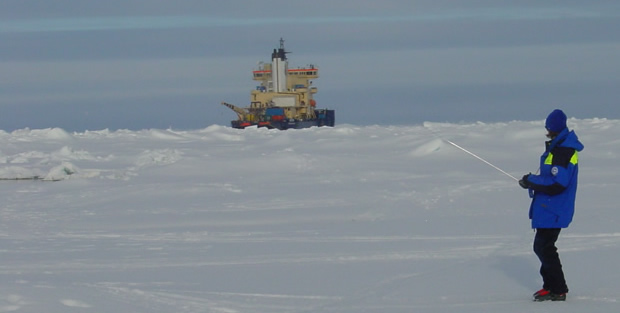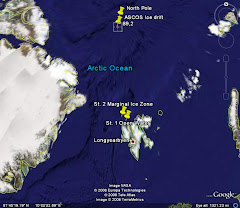At 87o 21.69N, 07o 28.73W, warmer at -1.7C, low winds. Low winds imply that the winds are not coming from a consistent and constant direction; this is not good for the atmospheric particles (=aerosol) and gases that are being sampled continuously on the 4th and 7th decks of Oden, as the exhaust from the single ship engine can be pulled in to the samples, sometimes destroying them. So Oden was turned to face into the wind this morning. Indeed, many of the variables measured in aerosols are in very low concentrations so they require a long sampling of 24h. If they become dirty towards the end of their sampling period, the sample is unusable, despite the effort. They have had a watch system with a scientist watching the pollution monitor around a clock. Sunday and Monday were very exciting for them as they had major events of new atmospheric particle formation (= nucleation events). These very tiny particles grow (= increase in size) to form cloud condensation nuclei (CCN) that provide the "seeds" that form the tiny cloud droplets that will lead to the formation of clouds and fog. The composition, appearance and number of cloud droplets and associated CCN affect the formation of clouds and how long they last. If the number of CCN increases, more, but smaller, cloud droplets will form. This will result in whiter, longer-lasting clouds that reflect more incoming sunlight back into space and allow less solar energy (= heat and light) to reach the sea and the ice surfaces here in the Arctic Ocean. So there is an effect on the biology in seawater and the melting/freezing of seawater and sea ice.
Despite the effort of our dedicated swimmers, the lead froze yesterday evening and we were not able to sample microlayer. This morning the helicopter pilot flew to the lead and created enough wind to crack the ice in a couple of places. We rushed to sample with the small microlayer boat and collected 300 ml of sample (not very much) before the lead started to freeze over again.
At 1900 GMT, Maine Public Broadcasting Network (Maine's National Public Radio station) called Oden to do an interview. It can be heard at
http://www.mpbn.net/radio/mainenews/080825acrtic.htm <http://mail.polar/exchweb/bin/redir.asp?URL=http://www.mpbn.net/radio/mainenews/080825acrtic.htm>
We told the journalist that there are 64 people on board= 21 from Oden + 10 from Swedish Polar Research Secretariat logistics (including 2 heli pilots, 2 bear guards, and the physician) + 31 scientists. We have 12 nationalities on board. We work 24h/ day, 7 days per week but also manage to have a social life with some people participating in one or more or none of these activities: karate class, ping pong tournament, cinema club, lecture series and we all celebrate birthdays.
We communicate with our friends, family and colleagues by Iridium email and phone.
We've had a high security level due to the polar bear "highway" we seem to be in but every one (crew, polar and scientists) are pitching in to provide bear guarding so those of us on the ice can do our work. Thank you!
In our lead group, an informal survey indicates that we miss Mexican food, fresh fruit, family and dogs, not necessarily in that order J
A small, unofficial survey indicates that we have been surprised by the small amount of life we can see which makes the surroundings a bit intimidating but the 3 polar bears and 4 seals are more than we expected and keep things exciting. Seeing a lot of ice algae is not as moving for most while Monica and Paty get very excited by their mucus. Those of us who have been here before are surprised by the earlier than expected freeze up and by the swimming activities of the captain and staff captain.
To the scout patrol in Santiago, Chile who sent the following questions, here you go. Send more questions! Thank you!
-¿que tienen que ver las microalgas en todos esto?
Las microalgas, ya sea que esten flotando en el fitoplancton o inmoviles en el hielo, fotosintetizan todo el tiempo mientras haya luz, igual que las plantas terrestres, creando material organica. Como estan en el agua, lo que sueltan queda disuelto en el agua que las rodea (asi como las plantas "sueltan" su perfume al aire que las rodea). Este material organico disuelto (incluyendo gases, particulas y sales) se junta en la superficie del agua, en la interface entre agua y aire (= capa superficial o "surface microlayer") donde esta ahora disponible para ser introducido a la atmosfera por el viento o burbujas.
-¿que tienen las microalgas que de origen al nucleo de las nubes?
Las microalgas producen un gas llamado dimetil sulfuro (DMS) que cuando es introducido en el aire es foto-oxidado por la luz solar a otros compuestos derivados, los cuales forman nucleos de condensacion. Ademas, las microalgas forman material organica disuelta la cual tambien forma microgeles (= "moco" microscopico, si, parecido al moco de la nariz J). Estas microgeles han sido observadas en el agua y en los aerosoles. Esta expedicion esta basada en la hipotesis que estas microgeles tambien actuan como nucleos de condensacion en el aire y, ademas, a veces proveen una superficie para la condensacion de los productos de la oxidacion del DMS.
-¿que les faltan a las algas para producir el nucleo ?
No esta claro. Se piensa que las microalgas producen DMS y el compuesto precursor DMSP (dimetil sulfuro propionato) en agues constantemente frias porque 1) hace frio, como un protector criogenico del material celular; 2) como un agente antibacteriano y an-predador; 3) cuando estan felices y creciendo activamente, como una via metabolica para eliminar energia en exceso (a traves de la formacion y eliminacion de aminoacidos y proteinas que contienen azufre); 4) como respuesta metabolica a un stress externo ambiental (demasiada radiacion ultravioleta, falta de nutrients, mucha luz y falta de luz)
-¿como podriamos ayudar desde aca?
Uds. pueden ayudar reduciendo la cantidad de particulas introducidas en el aire, ya sea quemando menos basura, calentado las casas con metodos que reducen las particulas en el aire, quemando eficientemente, ensenando a otros ninos y en el colegio lo importante que es reciclar, promoviendo la reduccion del smog. Reducir la cantidad de particulas en el aire es muy bueno para la salud y es muy importante para el ambiente.
Tuesday, August 26, 2008
Subscribe to:
Post Comments (Atom)






No comments:
Post a Comment